Global and Chinese Automakers’ Modular Platforms and Technology Planning Research Report, 2022
Research on Automakers’ Platforms and Their Planning: the Strategic Layout Directions of 32 Automakers
At present, global automotive industry is in the midst of profound changes unseen in a century. This can be intensively demonstrated through energy, power system, E/E architecture, intelligence and connectivity, application scenarios, user experience, and more. In this context, major automakers are changing their strategic layout. They work hard on key areas from automotive manufacturing platforms, E/E architecture and software platforms to autonomous driving, intelligent cockpit and electrification, and attract consumers and satisfy their needs with differentiated products.

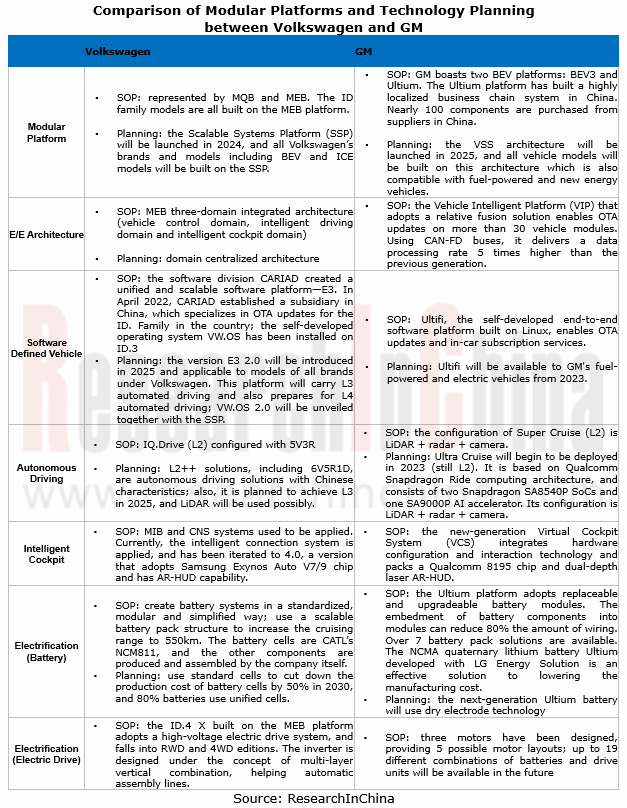
1. Automakers keep upgrading their modular platform architectures.
Modular platforms remain superior in increasing the universality of components and lowering R&D and production costs. At present, most automakers have their own modular platforms, or even multiple platforms. Modular architecture outperforms a modular platform. It is an extension and expansion of the platform concept. With higher universality of components and higher scalability, modular architecture is compatible with vehicles of differing classes and power types. Automakers therefore have started gradual transition from modular platform to modular architecture.
Modular architecture favors higher productivity, lower procurement/manufacturing costs, and shorter R&D cycles. In current stage, the generalization rate of components in GAC Global Platform Modular Architecture (GPMA) surpass 60%, compared with 70% in Geely Sustainable Experience Architecture (SEA) and 70%-80% in Toyota New Global Architecture (TNGA).
At present, automakers in China deploy modular architectures relatively early. Among them, BYD, Geely, Chery, and Changan Automobile have launched their own modular architectures. The modular architecture launches of foreign peers are concentrated in the period from 2024 to 2025.
Taking Volkswagen as an example, the company plans to eventually integrate its platforms into SSP, a scalable mechatronics platform architecture applicable to all Volkswagen’s brands and models. In the future, all brands and models at all levels under Volkswagen will be built on this super platform.
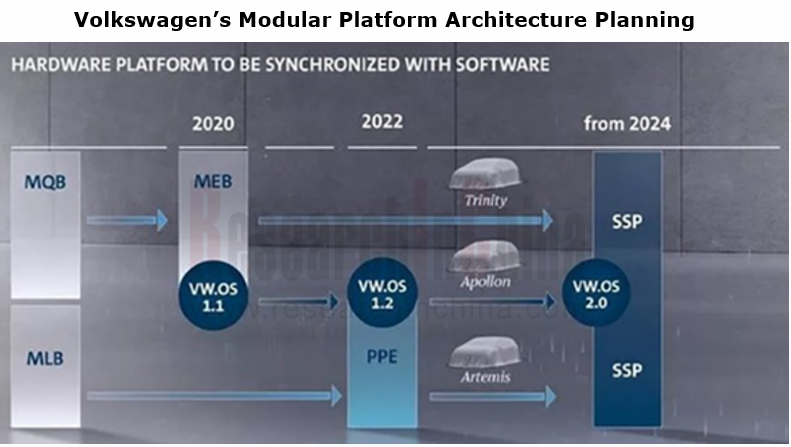
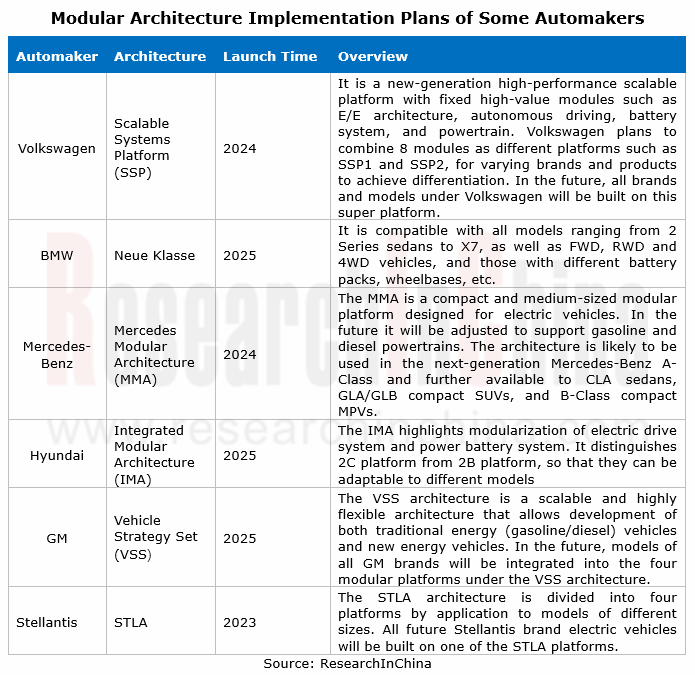
2. EEA tends to be centralized.
Through the lens of E/E architecture planning, most automakers plan to deploy centralized vehicle E/E architectures:
GAC projects installation of the centralized E/E architecture "Protoss" in 2023 Aion high-end models;
Hongqi plans launch of its quasi-central architecture FEEA3.0 in 2023;
Great Wall Motor plans to introduce its central computing architecture GEEP 5.0 in 2024;
Changan Automobile is expected to complete the development of its domain centralized architecture in 2025.
For example, GAC has upgraded its E/E architecture in all aspects and has developed the Protoss E/E Architecture, its new vehicle-cloud integrated E/E architecture that enables centralized computing and is about to come out in 2023 at the earliest. This architecture consists of three core computer groups, i.e., central computer, intelligent driving computer and infotainment computer, and four zonal controllers. The intelligent driving domain carries Huawei Ascend 610, a 400TOPS high-performance chip.
3. Automakers transform from independent software platform developers to software service providers.
As autonomous driving and intelligent connectivity boom, large automakers have set off a new round of “software-defined vehicle”-centric transformation and upgrading. Some transform themselves to software service providers by way of establishing software divisions/subsidiaries, independently developing operating systems (OS), and building software platforms.
Compared with the turnkey model in which Tier-1 suppliers take full charge in conventional vehicle supply chain, auto brands now take more active part. Joint R&D and flat cooperation gradually blur the boundaries of the supply chain ecosystem, and also diversifies the needs for business models. Modular services thus need providing to meet the individual needs of auto brands with differentiated configurations for different vehicle models. For example, Bosch adopts hardware modularization + middleware layer generalization + software individualization model and adjusts parameters to quickly address the needs of different functions.
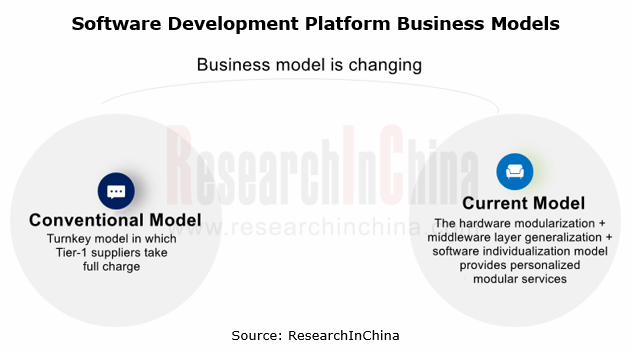
Volkswagen is a typical automaker that develops software on its own. In 2019, Volkswagen established a software division and planned to boost the in-house share of car software development from less than 10% to at least 60% in the five years to come. In 2021, Volkswagen changed the software division into CARIAD, a joint-stock company which will be responsible for independently developing the automotive operating system VW.OS and creating the software platform E3. In April 2022, CARIAD announced its China strategy. Its Chinese subsidiary was then established.
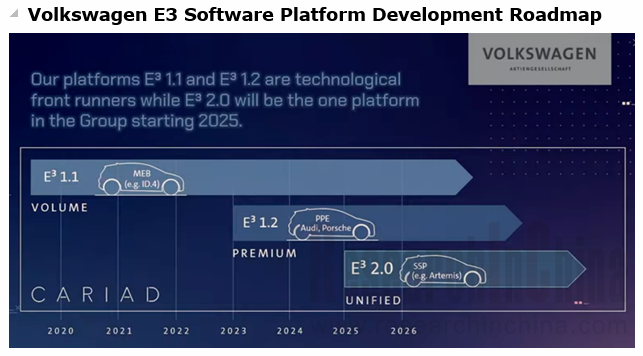
In addition to Volkswagen, GM, Toyota, Mercedes-Benz, Hyundai, SAIC and the like have also begun to self-develop operating systems and deploy their own software platforms, aiming to transform from an automaker to a software service provider. Toyota, which recently acquired the automotive operating system provider Renovo Motors, plans to roll out its own operating system, Arene, in 2025.
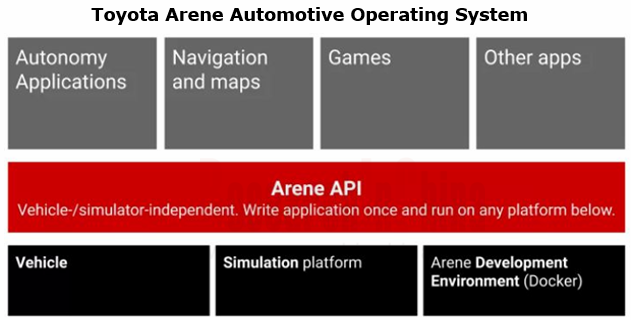
4. L3 automated driving of OEMs comes into service.
The mainstream automakers deploy autonomous driving in the following ways:
? Investing in acquiring autonomous driving startups
? Partnering with big tech firms
? Cooperating with other OEMs
? Self-developing, or combining the above ways
On this basis, these automakers have also introduced their own autonomous driving assistance systems, including Volkswagen IQ.Drive, Toyota Advanced Drive, Mercedes-Benz Drive Pilot, Geely G-Pilot, and GAC ADiGO. Among them, Mercedes-Benz is the world’s first automotive company to meet the United Nations regulation UN-R157. Mercedes-Benz marketed its L3 automated driving system Drive Pilot in Germany in May 2022, and announced that it will be responsible for accidents caused by the system when activated.
Sensor configuration of Mercedes-Benz Drive Pilot:
? 1 LiDAR
? 1 long-range radar
? 4 short-range radars
? 1 stereo camera
? 1 rear view camera
? 1 in-vehicle driver monitoring camera
? 1 differential GPS
Sensor configuration of automated parking:
? 4 surround view cameras
? 12 ultrasonic sensors
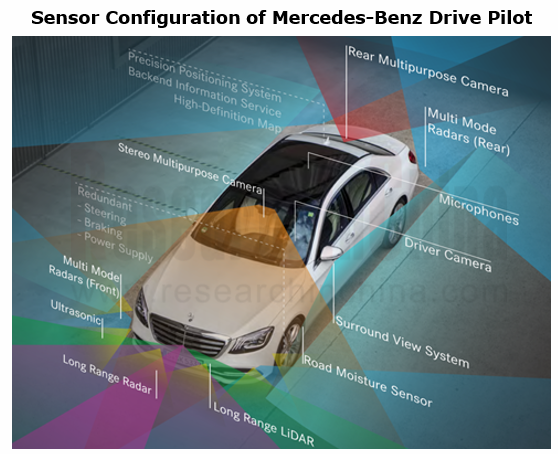
5. Intelligent cockpit interconnection platforms connect vehicles, people and everything, playing a more important role.
As the Internet thrives, major automakers show much enthusiasm for intelligent cockpits. Almost all of them have rolled out different intelligent cockpit interconnection platforms as selling points, in a bid to attract consumers. Examples include BMW iDrive and Mercedes-Benz MBUX, BYD DiLink and Geely GKUI.
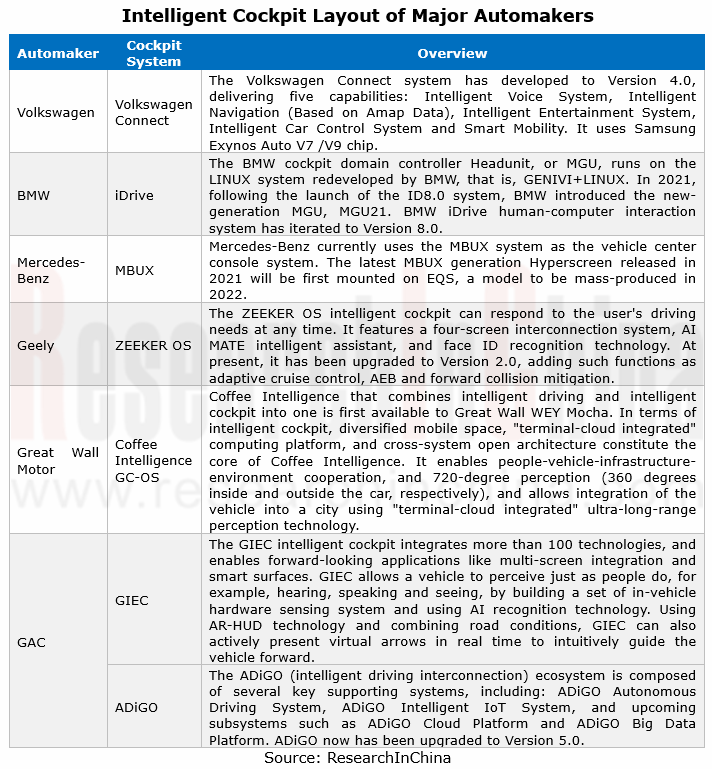
New Energy Vehicle Cross-Domain (Electric Drive System and Powertrain Domain) Integration Trend Report 2025-2026
Electric Drive and Powertrain Domain Research: New technologies such as three-motor four-wheel drive, drive-brake integration, and corner modules are being rapidly installed in vehicles.
Electric dri...
Analysis on Desay SV and Joyson Electronic's Electrification, Connectivity, Intelligence and Sharing, 2025
Research on Desay SV and Joyson Electronic: Who is the No.1 Intelligent Supplier?
Both Desay SV and Joyson Electronic are leading domestic suppliers in automotive intelligence. "Analysis on Desay SV ...
OEMs and Tier 1 Suppliers' Cost Reduction and Efficiency Enhancement Strategy Analysis Report, 2025
ResearchInChina released the "OEMs and Tier 1 Suppliers' Cost Reduction and Efficiency Enhancement Strategy Analysis Report, 2025", summarizing hundreds of cost reduction strategies to provide referen...
Automotive Fixed Panoramic Sunroof and Smart Roof Research Report, 2025
With the intelligent application of car roofs as the core, this report systematically sorts out a series of new products such as fixed panoramic sunroof/openable sunroof, ceiling screen, roof ambient ...
Automotive-Grade Power Semiconductor and Module (SiC, GaN) Industry Research Report, 2025
SiC/GaN Research: Sales volume of 800V+ architecture-based vehicles will increase more than 10 times, and hybrid carbon (SiC+IGBT) power modules are rapidly being deployed in vehicles.
Sales volume o...
Cockpit Agent Engineering Research Report, 2025
Cockpit Agent Engineering Research: Breakthrough from Digital AI to Physical AI
Cockpit Agent Engineering Research Report, 2025 starts with the status quo of cockpit agents, summarizes the technical ...
Prospective Study on L3 Intelligent Driving Technology of OEMs and Tier 1 Suppliers, 2025
L3 Research: The Window of Opportunity Has Arrived - Eight Trends in L3 Layout of OEMs and Tier 1 Suppliers
Through in-depth research on 15 OEMs (including 8 Chinese and 7 foreign OEMs) and 9 Tier 1 ...
China Commercial Vehicle IoV and Intelligent Cockpit Industry Research Report 2025
Commercial Vehicle IoV and Cockpit Research: The Third Wave of Passenger Car/Commercial Vehicle Technology Integration Arrives, and T-Box Integrates e-Call and 15.6-inch for Vehicles
I. The third wav...
Intelligent Vehicle Electronic and Electrical Architecture (EEA) and Technology Supply Chain Construction Strategy Research Report, 2025
E/E Architecture Research: 24 OEMs Deploy Innovative Products from Platform Architectures to Technical Selling Points
According to statistics from ResearchInChina, 802,000 passenger cars with domain...
Research Report on Intelligent Vehicle Cross-Domain Integration Strategies and Innovative Function Scenarios, 2025
Cross-Domain Integration Strategy Research: Automakers' Competition Extends to Cross-Domain Innovative Function Scenarios such as Cockpit-Driving, Powertrain, and Chassis
Cross-domain integration of ...
China Autonomous Driving Data Closed Loop Research Report, 2025
Data Closed-Loop Research: Synthetic Data Accounts for Over 50%, Full-process Automated Toolchain Gradually Implemented
Key Points:From 2023 to 2025, the proportion of synthetic data increased from 2...
Automotive Glass and Smart Glass Research Report, 2025
Automotive Glass Report: Dimmable Glass Offers Active Mode, Penetration Rate Expected to Reach 10% by 2030
ResearchInChina releases the Automotive Glass and Smart Glass Research Report, 2025. This r...
Passenger Car Brake-by-Wire (BBW) Research Report, 2025
Brake-by-Wire: EHB to Be Installed in 12 Million Vehicles in 2025
1. EHB Have Been Installed in over 10 Million Vehicles, A Figure to Hit 12 Million in 2025.
In 2024, the brake-by-wire, Electro-Hydr...
Autonomous Driving Domain Controller and Central Computing Unit (CCU) Industry Report, 2025
Research on Autonomous Driving Domain Controllers: Monthly Penetration Rate Exceeded 30% for the First Time, and 700T+ Ultrahigh-compute Domain Controller Products Are Rapidly Installed in Vehicles
L...
China Automotive Lighting and Ambient Lighting System Research Report, 2025
Automotive Lighting System Research: In 2025H1, Autonomous Driving System (ADS) Marker Lamps Saw an 11-Fold Year-on-Year Growth and the Installation Rate of Automotive LED Lighting Approached 90...
Ecological Domain and Automotive Hardware Expansion Research Report, 2025
ResearchInChina has released the Ecological Domain and Automotive Hardware Expansion Research Report, 2025, which delves into the application of various automotive extended hardware, supplier ecologic...
Automotive Seating Innovation Technology Trend Research Report, 2025
Automotive Seating Research: With Popularization of Comfort Functions, How to Properly "Stack Functions" for Seating?
This report studies the status quo of seating technologies and functions in aspe...
Research Report on Chinese Suppliers’ Overseas Layout of Intelligent Driving, 2025
Research on Overseas Layout of Intelligent Driving: There Are Multiple Challenges in Overseas Layout, and Light-Asset Cooperation with Foreign Suppliers Emerges as the Optimal Solution at Present
20...